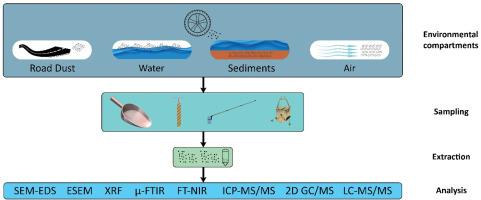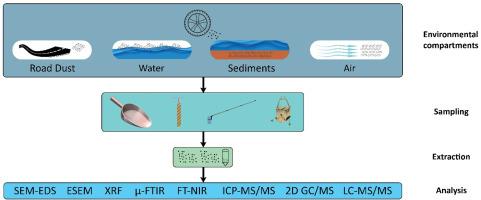轮胎和道路磨损颗粒取样、提取和分析方法综述
IF 7.3
2区 环境科学与生态学
Q1 ENVIRONMENTAL SCIENCES
引用次数: 0
摘要
轮胎和道路磨损颗粒(TRWPs)由于其在环境中的广泛分布已成为日益严重的污染问题。缺乏对trwp环境样本的采样、处理和分析方法(及其优点和局限性)的全面概述。我们对先前报道的水、空气、道路尘埃和沉积物/土壤样本的采样、处理和分析方法进行了评估和批判性评估。我们提出了研究这些介质中TRWPs的研究框架。显微镜和热分析技术,如扫描电子显微镜(带能量色散x射线分析),环境扫描电子显微镜,二维气相色谱-质谱法和液相色谱串联质谱法,在复杂样品的情况下,是确定trwp数量和质量的最佳方法。提出了有待进一步调查和分析的问题建议。本文章由计算机程序翻译,如有差异,请以英文原文为准。


A critical review of sampling, extraction and analysis methods for tyre and road wear particles
Tyre and road wear particles (TRWPs) have become an increasing contamination concern because of their extensive distribution in the environment. A comprehensive overview of the methods for sampling, treatment and analysis of environmental samples for TRWPs (and their benefits and limitations) is lacking. We evaluate and critically assess the sampling, treatment and analysis methods previously reported for water, air, road dust and sediment/soil samples. We suggest research frameworks for studying TRWPs in these media. Microscopy and thermal analysis techniques such as scanning electron microscopy (with energy dispersive X-ray analysis), environmental scanning electron microscopy, 2-dimensional gas chromatography mass spectrometry and liquid chromatography with tandem mass spectrometry in the case of complex samples, are optimal methods for determination of the number and mass of TRWPs. Issues for further investigation and analysis recommendations are provided.
求助全文
通过发布文献求助,成功后即可免费获取论文全文。
去求助
来源期刊

Environmental Pollution
环境科学-环境科学
CiteScore
16.00
自引率
6.70%
发文量
2082
审稿时长
2.9 months
期刊介绍:
Environmental Pollution is an international peer-reviewed journal that publishes high-quality research papers and review articles covering all aspects of environmental pollution and its impacts on ecosystems and human health.
Subject areas include, but are not limited to:
• Sources and occurrences of pollutants that are clearly defined and measured in environmental compartments, food and food-related items, and human bodies;
• Interlinks between contaminant exposure and biological, ecological, and human health effects, including those of climate change;
• Contaminants of emerging concerns (including but not limited to antibiotic resistant microorganisms or genes, microplastics/nanoplastics, electronic wastes, light, and noise) and/or their biological, ecological, or human health effects;
• Laboratory and field studies on the remediation/mitigation of environmental pollution via new techniques and with clear links to biological, ecological, or human health effects;
• Modeling of pollution processes, patterns, or trends that is of clear environmental and/or human health interest;
• New techniques that measure and examine environmental occurrences, transport, behavior, and effects of pollutants within the environment or the laboratory, provided that they can be clearly used to address problems within regional or global environmental compartments.
 求助内容:
求助内容: 应助结果提醒方式:
应助结果提醒方式:


